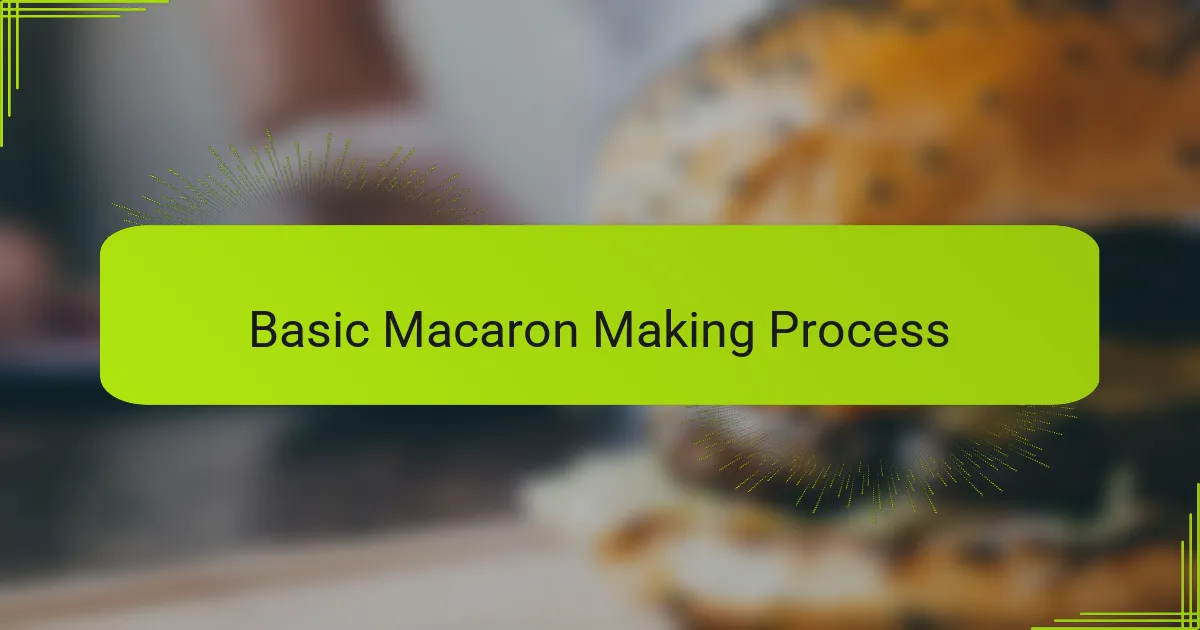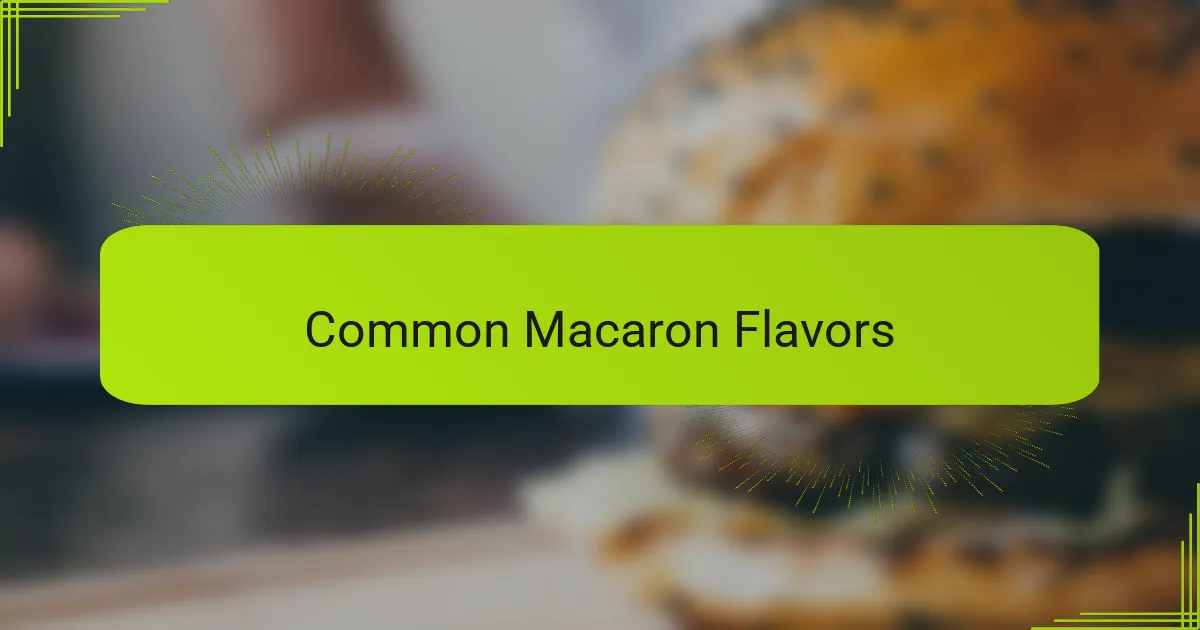Key takeaways
- Macarons are French cookies made from almond flour, egg whites, and sugar, featuring a unique texture and a wide variety of flavors.
- The macaron-making process requires precision and patience, especially during the meringue whipping and batter folding stages.
- Common flavors include classic options like pistachio, vanilla, and chocolate, along with adventurous seasonal flavors that enhance their versatility.
- Mastering the techniques for perfect macarons, such as allowing resting time and proper folding, is crucial for achieving the desired texture and appearance.

What Are Macarons
Macarons are delicate French cookies made primarily from almond flour, egg whites, and sugar. Their crisp outside and soft, chewy interior create a unique texture that’s hard to find in other desserts. I still remember the first time I bit into a macaron—I was instantly enchanted by the explosion of flavor and the lightness that made it feel like a little treat from heaven.
Have you ever wondered why these tiny pastries come in so many colors and flavors? Each macaron is essentially two almond meringue shells sandwiched with a creamy filling, ranging from fruity jams to rich ganaches. This combination allows for endless creativity, which is probably why I find myself drawn to trying every new flavor that comes my way.
What strikes me most about macarons is their sophisticated simplicity. They look elegant, but making them is a precise art—one that requires patience and care. For me, enjoying a macaron is not just about savoring a dessert; it’s appreciating the skill and passion behind every bite.

Key Ingredients In Macarons
Almond flour is the heart of macarons, giving them that signature nutty flavor and tender crumb. I remember the first time I realized how much this ingredient mattered—it was like the difference between something ordinary and something truly special.
Egg whites play a crucial role, whipped into a meringue that creates the cookie’s delicate structure. Without perfectly beaten egg whites, the shells just won’t have that airy crispness I’ve come to love.
Of course, sugar isn’t just for sweetness; it stabilizes the meringue and balances the almond’s earthiness. It’s fascinating how such simple ingredients come together to form a dessert that feels both light and indulgent at the same time.

Basic Macaron Making Process
The basic macaron making process always reminds me of a delicate dance in the kitchen—each step has to be just right. First, whipping the egg whites to stiff peaks feels like capturing a cloud, and I’ve learned that timing here can make or break the final texture. Have you ever been tempted to rush this part? Trust me, patience is key.
Then comes the folding of almond flour and powdered sugar into the meringue—a move I approach with both excitement and caution. I found that folding too much deflates the batter, while too little leaves it too stiff; finding that perfect flow, or “macaronnage,” feels almost like a secret handshake with the batter itself. It’s an art I enjoy mastering with each batch.
Finally, piping the batter onto the baking sheet and letting the shells rest before baking is where anticipation builds. Watching those little circles develop feet in the oven is honestly one of the most satisfying moments; it feels like all the patience is paying off. Have you ever held your breath as the timer ticks down, hoping for that perfect rise? I certainly have—and it’s always worth it when the first bite delivers that iconic crunch and chew.

Common Macaron Flavors
When it comes to common macaron flavors, I’ve always found myself drawn to the classics. Think pistachio, vanilla, chocolate, and raspberry—each one offering a distinct taste that feels familiar yet special. Have you ever noticed how the subtle nuttiness of pistachio pairs perfectly with the crisp shell? It’s a flavor that never gets old in my book.
Lemon and salted caramel are flavors that often surprise me with their balance of sweet and tangy or salty notes. I remember trying a salted caramel macaron at a café, and that moment when the rich caramel filling met the delicate cookie shells felt like a tiny celebration. It’s these contrasts that make common flavors so exciting to revisit.
Of course, seasonal and more adventurous flavors also peek through, but the staples remain favorites because they capture what macarons do best: blending texture with memorable taste. From fruity to nutty, each basic flavor tells a little story, and I find myself eagerly anticipating which one I’ll enjoy next. Have you found a favorite among these classics yet?

My Experience Baking Macarons
Baking macarons was a rollercoaster for me—initial attempts often ended with cracked shells or no “feet” at all. I remember feeling both frustrated and fascinated, wondering how such a small cookie could demand so much precision. Have you ever had a kitchen adventure that felt that way, where every detail mattered?
One thing I quickly realized is that patience isn’t just a virtue; it’s the secret ingredient. Waiting for the piped batter to rest long enough before baking became almost meditative, and those moments of stillness made the final result feel like a personal victory. There’s something deeply satisfying about seeing those delicate feet form in the oven, knowing all the effort paid off.
Over time, I learned to trust my instincts with the folding technique, feeling the batter change beneath my spatula. It’s almost like the batter tells you when it’s ready, and I found myself tuning into those subtle cues more than any recipe. Have you noticed how some skills just click after a little patience and practice? That’s exactly how baking macarons felt for me.

Tips For Perfect Macarons
Getting the perfect macaron shell comes down to mastering one crucial tip: don’t rush the resting period. I remember the first time I neglected this step—the cookies cracked and looked dull. Waiting for that slightly dry skin to form on top before baking might feel like extra time, but trust me, it’s what gives macarons their signature smooth surface and those elegant “feet” at the base.
Another lesson I learned the hard way was with the folding—or “macaronnage.” It’s tempting to either under- or over-mix the batter, especially when you’re eager to see results. Have you ever felt that moment when the batter suddenly looks just right—glossy, flowing slowly off the spatula like molten lava? That’s the perfect texture you want. I’ve found that tuning into these visual cues makes all the difference between a flat cookie and a delicate, airy delight.
Finally, temperature and timing during baking can’t be overlooked. I once thought a higher oven heat would speed things up, but it ended in burnt edges and hollow centers. Now, I stick to a lower temperature and watch closely. It’s a small patience game, but when you pull out a tray of macarons that have risen perfectly with no cracks, you realize it’s a game worth playing. Have you ever experienced that pride in nailing a difficult bake? It’s incredible.

My Favorite Macaron Recipes
When it comes to my favorite macaron recipes, I always find myself reaching for classics like pistachio with a hint of rose or rich chocolate ganache. There’s something about the way the nutty, floral, and creamy flavors meld together that feels comforting yet indulgent. Have you ever tried a pistachio-rose combination? It’s surprisingly elegant and utterly addictive.
One recipe I hold dear is a salted caramel macaron that I perfected after several attempts. I remember the first batch was too sweet, but tweaking the caramel’s saltiness made all the difference. That balance of salty and sweet still surprises me every time I take a bite—do you know that moment when a simple flavor combo suddenly feels gourmet? That’s exactly the feeling I chase with my macarons.
Occasionally, I experiment with seasonal flavors like pumpkin spice or lavender honey, which bring a fresh twist but don’t stray too far from what I love. Baking these reminds me how versatile macarons can be, yet the best recipes always stay true to that signature delicate texture and seamless harmony of tastes. Have you discovered a flavor that reshaped your idea of what macarons can be? I find that’s part of the joy in baking them myself.




